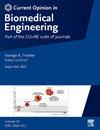通过在模型组织中嵌入传感器的生物力学新观点:通往临床的途径
IF 4.2
3区 工程技术
Q2 ENGINEERING, BIOMEDICAL
引用次数: 0
摘要
组织的机械特征已被认为是疾病进展的关键驱动因素,并越来越多地作为诊断和治疗目标进行研究。集成嵌入式生物力学传感器的工程组织模型最近揭示了微观和纳米尺度环境下复杂的力学行为,为发育和疾病机制提供了新的见解。通过将定制的生物力学传感器嵌入工程组织,特别是针对癌症和纤维化等软组织病变,这种简短的意见综合了新兴的机械特征,这些特征已经在高测量灵敏度和空间分辨率下被识别出来。然后,我们描述了在临床实践中实现这些增加的解决方案的挑战,并强调了最近可能最终弥合这些差距的创新策略。如果成功,这些改进的生物力学测量系统将为改善诊断和患者预后开辟新的途径。本文章由计算机程序翻译,如有差异,请以英文原文为准。
Emerging views of biomechanics via embedded sensors in model tissues: Pathways to the clinic
Mechanical features of tissues have been recognised as key drivers of disease progression and are increasingly investigated as diagnostic and therapeutic targets. Engineered tissue models with integrated embedded biomechanical sensors have recently uncovered complex mechanical behaviors across micro- and nanoscale environments, offering novel insights into developmental and disease mechanisms. This short opinion synthesizes emerging mechanical signatures that have been identified at high measurement sensitivities and spatial resolutions by embedding customized biomechanical sensors into engineered tissues, particularly for soft tissue pathologies like cancer and fibrosis. We then describe the challenges of achieving these increased resolutions in clinical practice, and highlight recent innovative strategies that may ultimately bridge these gaps. If successful, these improved biomechanical measurement systems could open new pathways for improving diagnostics and patient outcomes.
求助全文
通过发布文献求助,成功后即可免费获取论文全文。
去求助
来源期刊

Current Opinion in Biomedical Engineering
Medicine-Medicine (miscellaneous)
CiteScore
8.60
自引率
2.60%
发文量
59
 求助内容:
求助内容: 应助结果提醒方式:
应助结果提醒方式:


